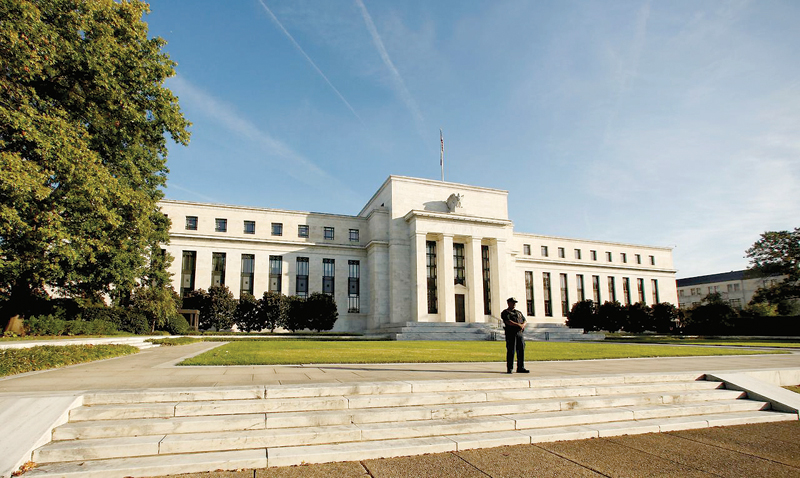

Jonnelle Marte -
The Federal Reserve’s bond portfolio is swelling again at a pace not seen since the “quantitative easing” heyday in the early 2010s. Prices for stocks and other risky assets are also rising at a fast clip — a state of affairs that a growing chorus of investors, economists and former Fed officials say is no coincidence, and potentially a problem.
Since the Fed started buying $60 billion of Treasury bills a month last fall to counter ructions on short-term money markets, credit spreads are tighter and the bank funding markets targeted by the purchases are calmer. Financial stress measures tracked by regional Fed banks are at their lowest in a year or more — all signs of the programme’s success.
The S&P 500 also is up more than 10 per cent since October.
It all sets the stage for the first tricky manoeuvre the Fed will undertake this year: turning off the tap. A misstep could have painful consequences.
“The risk is what happens when the Fed stops increasing their balance sheet,” said Peter Boockvar, chief investment officer with Bleakley Advisory Group. “What will stocks do when that liquidity spigot stops? We’ll have to see.”
In the wake of the financial crisis of 2007-2009, the central bank acquired a vast portfolio of Treasuries and mortgage-backed securities — topping $4.5 trillion at its peak — through three operations known as quantitative easing, or QE.
While designed to help lift the economy after the crisis by holding down long-term interest rates, QE also had a side-effect that appears to be replaying now: Prices for risky assets like stocks and low-quality corporate bonds rose as the Fed’s portfolio grew.
Fed Chair Jerome Powell and other policymakers have asserted their latest balance sheet expansion is a technical adjustment and not stimulus. “Our Treasury bill purchases should not be confused with the large-scale asset purchase programmes that we deployed after the financial crisis,” Powell said after October’s policy meeting.
Many market watchers aren’t buying it, and several have dubbed it “QE Lite.” “You can debate it all you want, but as long as the flows are increasing the size of the balance sheet, stocks are going to rise in price,” said Danielle DiMartino Booth, founder of Quill Intelligence, a boutique research firm, and a past adviser to former Dallas Fed President Richard Fisher.
Fisher, who ran the Dallas Fed from 2005 to 2015, said the influence on markets could be driven mainly by expectations created during earlier rounds of QE, which corresponded with hefty stock market gains.
“Markets perceive things and they may perceive things different than what you intend,” Fisher said, pointing to a strong correlation between the increase in the size of the Fed’s balance sheet and the rise in stock prices. “But there’s also a real effect.” The S&P rose roughly 37 per cent during both QE1 and QE3, and by 10 per cent under QE2, which was the smallest operation of the three. It has gained 11 per cent since the new T-bill purchases were announced.
Not everyone is convinced the Fed should get credit for the stock rally, pointing to an easing of trade tensions with China and greater optimism about the US economy.
“Instead, the main causes of the upturn in the stock market since October have probably been signs of economic recovery at home after a temporary slowdown during much of 2019,” John Higgins, chief markets economist for Capital Economics, wrote in a research note to clients.
In a sense, the Fed faces a dilemma of its own making.
It jumped back into the bond-buying business in mid-October after a critical corner of US money markets seized up. It was an episode likely aggravated by the Fed having allowed its balance sheet to shrink too much in the post-QE era, and that left a shortage of reserves in the banking system.
The current effort is designed to replenish those drained reserves, which fell by 50 per cent from their peak level of about $2.8 trillion at the end of QE3 in late 2014 to $1.4 trillion last September.
They have since rebounded and are nearing $1.7 trillion thanks to the fastest pace of asset accumulation since the early days of QE3.
The Fed has been vague about how long the current programme will run but has said the T-bill purchases will continue into the second quarter.
So a decision on calling time on “QE Lite” is rapidly approaching, though it is not clear if policymakers are prepared yet to announce their plans. It will certainly be debated as they gather in Washington for their first meeting of the year, and the perception that it has become a stimulus programme is worrying for some.
Dallas Fed President Robert Kaplan said earlier this month he is aware of concerns the bill purchases may be driving up risky assets and said officials should try to limit growth of the balance sheet.
“It’s one of several factors that I think may be exacerbating the valuation of risky assets, so as a central banker I have to be cognizant of it,” he said. — Reuters
Oman Observer is now on the WhatsApp channel. Click here



